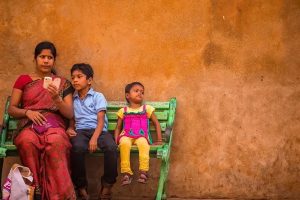Adoption and usage: What else should we consider?

Photo by Matias Planas on Shutterstock.
In line with other research, we find considerable effects of age, gender and literacy levels on interaction with smartphones and app based financial and agricultural information solutions. Through focus group discussions with micro, small and medium farmers across the three states of Uttar Pradesh, Karnataka and Nagaland, we find that elder populations interact less with smart-phone applications, and the younger household members who interact more, are moving out of agricultural work. Additionally, women are more excluded from access to digital services, especially in Uttar Pradesh. Converting awareness to usage is mainly hindered by low technological and technical knowledge of smart-phones, application availability and potential of usage. In this context, we find the presence of strong local social networks that are leveraged to discuss and share relevant news and information regarding agri-decisions, and in some cases, local networks are relied upon for obtaining app-based services as well. In the next in this series of blog posts, we explore three less discussed themes associated with adoption and usage — the form and type of information, gender and decision-making, and current design of applications.
How does the form and type of information matter?
It is worth remembering that an entire generation of IVRS and SMS-based information services have been implemented and studied over the past decade, in various parts of the world. Two results are of particular significance here:
i) Most evaluations of SMS based market price information interventions have had little or no impact (Camacho & Conover, 2011; Fafchamps & Minten, 2012)
ii) At the same time, IVRS based agro-advisory services have had better results, in studies from both India (Cole et al, 2014), and Africa.
These results are greatly significant today, in the context of proliferation of mobile applications offering similar services. An important body of work (Burrell& Oreglia, 2015; Weiche & Steinfeld, 2015)– relying on qualitative research methods — points out that an important drawback of the SMS based services was a potential lack of human touch, while also highlighting the many struggles faced by farmers in navigating the services. They also point out that price information by itself is meaningless — given the presence of strong local networks among other factors. Our fieldwork suggests that these earlier results are still very relevant, even in the context of mobile-app based services. Insights from our focus group discussions have suggested that the presence of strong social networks, and the lack of supporting mechanisms do result in barriers to the use of price information.
Thus in context of our study, these are important questions to consider: can good app design make-up for a lack of human touch? Do voice prompts, or videos, or phone based assistance make a difference in the influencing adoption and take-up of app-based solutions?
Is there more to a gender literacy gap?
Research so far has touted the widening gender gap in smart-phone ownership and technological literacy as the main reasons for the low adoption and usage of digital financial and agricultural services amongst women. However, there is reason to believe that the gap is more systemic and the need for this technology precedes ability. In rural farmer segments, frequent personal financial transactions are limited to mobile recharges and making payments of small amounts for daily provisions. Given the ease of paying in cash for this size of transactions and low ecosystem acceptance, building a strong rationale for converting these payments to digital platforms is proving difficult; this leaves business related transactions. In farmer families, although there is a feminization of the agricultural work-force, we find that most women work on the fields or rear the cattle, but play little role in payments and market linkages. Male household members mainly facilitate negotiating with the middle man, fixing prices for selling crops, purchasing inputs, moving goods to the cold storage and to the mandi (marketplace); these are the functions that applications in the current financial and agri-information space provide. Thus, there is a much deeper gap that excludes women from adopting digital services.
How do current applications fare in terms of design?
A thorough search of online databases, lists, and application stores on Android generated a list of over 150 applications that cater to farmers in terms of providing agricultural information and/or financial services in the Indian market. To narrow down this list to around 40 applications, our selection criteria included the number of downloads, availability in local languages, agricultural and/or payment functionalities, geographic spread, and date of last update. Using CGAP’s design principles (CGAP, 2016) as a guideline for best practices, we contextualized and quantified various design principles into indicators that allowed us to score each application against the best practice. The criteria included indicators for navigation (visual cues, important elements, information per screen), language (interface translation, complete translation, clear/simple language), data entry ease (alpha-numeric key board, automatic display of keyboard, easy display), errors (error messages, validate inputs, description of error), confirmations (review details of transaction, display pertinent details of transaction, display success of transaction), assistance (in-line instructions, directly calling customer care, in-application diagnostic tools, check network connectivity), and transaction records, if applicable (visual cues, transaction history search).
Interestingly, we find that all selected financial services and agri-information service applications score quite poorly in our attempt to evaluate them against best practice designs. Most applications score highly across criteria of navigation ease and error displays, however, fall short on data-entry and assistance provisions. Further, whilst there is some variation in the scores of agri-information service applications, financial service applications seem to cluster around the same score. The implications of this is two-fold — first, this provides an understanding of where the supply side gaps lie in app design and how training materials and literacy building initiatives can be designed to overcome design gaps. Focusing on adequate practice in entering data and leveraging social networks for assistance seem the key ways to plugging learning obstacles for rural segments. Secondly, we wonder whether similarity in design feasibility will ensure that farmers are able to learn the applications at a faster pace — in this regard, the difference in variation between agricultural and financial applications sets the base for our hypothesis of cross-usability of different platforms. To this end, we will be conducting games to test whether learning one application eases use of another, whether skills learnt are truly transferable and the effect of design on this.
References
Burrell, J., & Oreglia, E. (2014). The Myth of Market Price Information: Mobile Phones and the Application of Knowledge in Economics and ICTD. Economy and Society.
Camacho, A., & Conover, E. (2011). The Impact of Receiving Price and Climate Information in the Agricultural Sector. Inter-American Development Bank.
Cole, S., & Fernando, N. (2014). The Value of Advice: Evidence from the Adoption of Agricultural Practices.
Fafchamps, M., & Minten, B. (2011). Impact of SMS Based Agricultural Information on Indian Farmers.
Wyche, S., & Steinfeld, C. (2015). Why Don’t Farmers Use Cell Phones to Access Market Prices? Technology Affordances and Barriers to Market Information Services Adoption in Rural Kenya. Infromation Technology for Development.
This research was developed as part of the Bharat Inclusion Research Fellowship.
